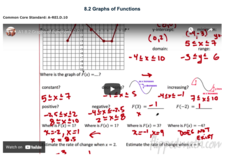Flipped Math
Graphs of Functions
Create a graphical description. Pupils watch a video presentation starting with vocabulary on properties of a graph of a function and then use the vocabulary to find key features of graphs of a function. Scholars use three graphs in the...
C-SPAN
Federal Court Structure
Many middle schoolers might have heard of the Supreme Court but few are aware of the structure of the Federal Court System. 11 video clips introduce the three levels of the Federal Court and the Katz v. U.S. case is used to demonstrate...
MinuteEarth
Why Are Leaves Green? Part 1
Consider a question that baffles even scientists. Why are leaves green? The video lesson offers a theory that begins with the first aquatic plants. Learners consider alternative explanations as well.
American Museum of Natural History
They Glow!
Would you believe marine animals can make their own light? An online resource describes the process of bioluminescence and how animals in the ocean use it to survive. The lesson features a catchy tune that describes the behavior of ocean...
Berkeley University of California
Colored Solution and Pen Laser
How does color follow the wave model of electromagnetic radiation? A video demonstrates experiments to model both absorption and emission of the color spectrum.
DoodleScience
Heat Transfer - Radiation
How is it possible that we can feel the heat of a sun that is so far from Earth? Study the type of heat transfer that makes this possible! The video introduces learners to radiation and how it functions when transferring heat.
statisticsfun
How to Calculate Margin of Error Confidence Interval for a Population Proportion
Teach how to find a confidence interval from a population proportion and margin of error with a video that reviews how to find a population proportion and a margin of error. The instructor then explains how to create a confidence...
Fuse School
Collision Theory and Reactions
The first lesson in a 35-part video series explains how orientation and energy determine a successful collision reaction. Scholars examine the requirements for a collision reaction to take place and come to understand that the...
Fuse School
Equilibrium-Dynamic and Changing
Explore the characteristics of a reaction in dynamic equilibrium. The 12th installment in a series of 35 video lessons discusses the concept of dynamic equilibrium. The video instructor uses animation to demonstrate the process.
Fuse School
Calculating Masses in Electrolysis
Investigate the calculation of molecular masses resulting from electrolysis of compounds. A video instructor gives a thorough explanation of mass calculations in relation to an electrolysis redox reaction. The video shows the formula,...
MinutePhysics
How Lasers Work (In Theory)
Show laser focus through an engaging video lesson that explains the design of a laser. It includes an explanation of the behavior of photons as they work together to produce the laser.
Fuse School
Rates of Reactions—Part 2
Learners examine the factors that affect reaction rates in the sixth lesson in a 35-part video series. The video instructor explains the different factors that change reaction rates, and the connection between volume, pressure, and...
Fuse School
Electron Exchange in Oxidation-Reduction Reactions
Examine how to determine the electron exchange in oxidation-reduction reactions. The 20th lesson in a series of 35 begins a discussion of redox reactions. The video instructor explains how to use half equations with electrons to create a...
Fuse School
Ionic Equations
Your classes should get a charge out of this one! Young scholars use ionic charges to determine balanced equations in the 23rd lesson of the 35-part series. The video instructor shows several examples varying in difficulty to wrap up a...
National Science Foundation
Science of NFL Football: Newton's Second Law of Motion
Newton would have been a great football coach. A 10-part video series examines several physics topics through a football lens. Using Newton's Second Law of Motion, individuals learn how force applies to kicking a football.
National Science Foundation
Science of NFL Football: Kinematics
Describe the motion of a football running back using physics kinematics. The seventh lesson in a series of 10 video lessons describes the velocity, acceleration, and position of key plays on the football field. Individuals learn the...
Fuse School
Relative Atomic Mass
Investigate how to calculate the relative atomic mass of elements. The video instructor explains how isotopes occur naturally for many elements. She then describes the process of calculating the relative atomic mass of an element using...
Fuse School
Catalytic Converters
Investigate the chemistry implemented in cars that keep our air safe. Scholars learn the role of the catalytic converter in changing dangerous gases to harmless byproducts. The video instructor discusses the specific chemical reactions...
Fuse School
Reducing Particulates (Soot)
Understand your daily role in environmental chemistry. An informative video discusses the origination of particulate matter in our world. It considers both indoor and outdoor origination of particulates and how to reduce their impacts.
Fuse School
Aluminium: Uses and Anodising
What is the most common element in Earth's crust? Aluminum! Although abundant, extracting the element is every expensive. The video lesson explains the properties of aluminum and what makes it a valuable element in everyday items.
MinuteEarth
Who Are Flowers Trying to Seduce?
Learn the tricks plants use to attract insects and animals in their quest for pollination. A thorough video lesson describes plant adaptations that meet their reproductive needs. From bees to rodents to bats, the narrator describes how...
FuseSchool
Finding the Gradient of a Straight Line
Investigate the relationship between the gradient, or slope, of a line and its graph. Pupils learn to use a graph to calculate the slope of a line. The video lesson includes both positive and negative slopes and compares the steepness of...
TED-Ed
How Your Muscular System Works
Get ready for some heavy lifting! A detailed video lesson explains the different muscle groups and their functions. The presenter compares and contrasts different types of muscle compositions related to their purposes.
Socratica
What Is a Black Hole? Black Holes Explained
Black holes are not just events in sci-fi movies—they're part of real life! Learners experience the creation of a black hole as they watch an episode of the Socratica playlist. The presenter explains the creation and composition of these...

























